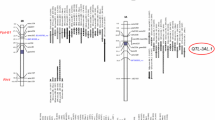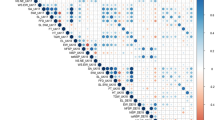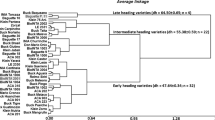Abstract
In the spring wheat-growing regions of western Canada, early maturity is an important trait for timely harvest to avoid frost damage, and associated harvest and post-harvest problems. Earliness is genetically regulated by vernalization, photoperiod, earliness per se genes, and complex gene interactions. In this study, we explored the effect of these gene complexes on the expression of 11 agronomic traits in the CDC Teal × CDC Go Canadian western red spring wheat-mapping population. The population of 187 recombinant inbred lines was genotyped with 341 DArT polymorphic markers and a functional Vrn-B1 marker, and phenotyped over 3 years in replicated trials. The dominant allele of Vrn-B1 reduced the number of days to heading, flowering and maturity, and increased leaf color concentration and plant height, but did not affect grain yield in the presence of common genetic backgrounds with dominant Vrn-A1a and Ppd-D1 alleles at two epistatic loci, Vrn-A1 and Ppd-D1. A total of 21 QTLs were identified for all phenotypic traits recorded, except plant height and grain protein content. Two earliness per se QTLs were mapped on chromosomes 1A (QEps.dms-1A) and 4A (QEps.dms-4A) in all three growing seasons, contributing 15–27 and 8–10 %, respectively, to the total genetic variation in days to maturity. The two earliness QTLs and Vrn-B1 exhibited additive interaction. Lines carrying dominant alleles at these three loci headed, flowered and matured 1.7, 1.9 and 4 days earlier, respectively, but yielded 0.43 t ha−1 less than lines with recessive alleles.


Similar content being viewed by others
References
AACC (2000) Approved methods of the American association of cereal chemists, 10th edn. AACC, St. Paul
Akbari M et al (2006) Diversity arrays technology (DArT) for high-throughput profiling of the hexaploid wheat genome. Theor Appl Genet 113:1409–1420
Appendino ML, Slafer GA (2003) Earliness per se and its dependence upon temperature in diploid wheat lines differing in the major gene Eps-A(m)1 alleles. J Agric Sci 141:149–154
Araki E, Miura H, Sawada S (1999) Identification of genetic loci affecting amylose content and agronomic traits on chromosome 4A of wheat. Theor Appl Genet 98:977–984
Asif M, Yang RC, Navabi A, Iqbal M, Kamran A, Lara EP, Randhawa H, Pozniak C, Spaner D (2015) Mapping QTL, selection differentials, and the effect of under organic and conventionally managed systems in the Attila × CDC go spring wheat mapping population. Crop Sci 55:1129–1142
Baloch DM, Karow RS, Marx E, Kling JG, Witt MD (2003) Vernalization studies with Pacific Northwest wheat. Agron J 95:1201–1208
Bullrich L, Appendino ML, Tranquilli G, Lewis S, Dubcovsky J (2002) Mapping of a thermo-sensitive earliness per se gene on Triticum monococcum chromosome 1A(m). Theor Appl Genet 105:585–593
Campbell A, Czarnecki E (1987) Katepwa hard red spring wheat. Can J Plant Sci 67:229–230
Chen A, Dubcovsky J (2012) Wheat TILLING mutants show that the vernalization gene VRN1 down-regulates the flowering repressor VRN2 in leaves but is not essential for flowering. PLoS Genet 8. doi:10.1371/journal.pgen.1003134
DePauw R, Townley-Smith T, McCaig T, Clarke J (1988) Laura hard red spring wheat. Can J Plant Sci 68:203–206
DePauw R et al (2005) Lillian hard red spring wheat. Can J Plant Sci 85:397–401
DePauw R, Knox R, McCaig T, Clarke F, Clarke J (2011) Carberry hard red spring wheat. Can J Plant Sci 91:529–534
Distelfeld A, Li C, Dubcovsky J (2009) Regulation of flowering in temperate cereals. Curr Opin Plant Biol 12:178–184
Faricelli ME, Valarik M, Dubcovsky J (2010) Control of flowering time and spike development in cereals: the earliness per se Eps-1 region in wheat, rice, and Brachypodium. Funct Integr Genomics 10:293–306
Flood RG, Halloran GM (1983) The influence of certain chromosomes of the hexaploid wheat cultivar thatcher on time to ear emergence in Chinese spring. Euphytica 32:121–124
Fox S et al (2007) AC Splendor hard red spring wheat. Can J Plant Sci 87:883–887
Fu D et al (2005) Large deletions within the first intron in VRN-1 are associated with spring growth habit in barley and wheat. Mol Genet Genomics 273:54–65
Gawronski P, Schnurbusch T (2012) High-density mapping of the earliness per se-3A(m) (Eps-3A(m)) locus in diploid einkorn wheat and its relation to the syntenic regions in rice and Brachypodium distachyon L. Mol Breed 30:1097–1108
Greenup A, Peacock WJ, Dennis ES, Trevaskis B (2009) The molecular biology of seasonal flowering-responses in Arabidopsis and the cereals. Ann Bot 103:1165–1172
Hanocq E, Laperche A, Jaminon O, Lainé AL, Le Gouis J (2007) Most significant genome regions involved in the control of earliness traits in bread wheat, as revealed by QTL meta-analysis. Theor Appl Genet 114:569–584
Holland JB (2006) Estimating genotypic correlations and their standard errors using multivariate restricted maximum likelihood estimation with SAS Proc MIXED. Crop Sci 46:642–654
Holland JB, Nyquist WE, Cervantes-Martinez CT (2003) Estimating and interpreting heritability for plant breeding: an update. Plant Breed Rev 22:9–112
Hoogendoorn J (1985) A reciprocal F1 monosomic analysis of the genetic-control of time of ear emergence, number of leaves and number of spikelets in wheat (Triticum aestivum L.). Euphytica 34:545–558
Hori K et al (2007) Barley EST markers enhance map saturation and QTL mapping in diploid wheat. Breed Sci 57:39–45
Huang XQ, Kempf H, Ganal MW, Roder MS (2004) Advanced backcross QTL analysis in progenies derived from a cross between a German elite winter wheat variety and a synthetic wheat (Triticum aestivum L.). Theor Appl Genet 109:933–943
Huang XQ et al (2006) Molecular detection of QTLs for agronomic and quality traits in a doubled haploid population derived from two Canadian wheats (Triticum aestivum L.). Theor Appl Genet 113:753–766
Hughes G, Hucl P (1993) CDC Teal hard red spring wheat. Can J Plant Sci 73:193–197
Iqbal M, Navabi A, Yang R-C, Salmon DF, Spaner D (2007) Molecular characterization of vernalization response genes in Canadian spring wheat. Genome 50:511–516
Kamran A et al (2013a) Earliness per se QTLs and their interaction with the photoperiod insensitive allele Ppd-D1a in the Cutler × AC Barrie spring wheat population. Theor Appl Genet 126:1965–1976
Kamran A, Randhawa HS, Pozniak C, Spaner D (2013b) Phenotypic effects of the flowering gene complex in Canadian spring wheat germplasm. Crop Sci 53:84–94
Kamran A, Randhawa HS, Yang R-C, Spaner D (2014) The effect of VRN1 genes on important agronomic traits in high-yielding Canadian soft white spring wheat. Plant Breed 133:321–326
Law CN (1987) The genetic control of day-length response in wheat. In: Atherton JG (ed) Manipulation of flowering. Butterworths, London, pp 225–240
Li Y et al (2012) Novel and favorable QTL allele clusters for end-use quality revealed by introgression lines derived from synthetic wheat. Mol Breed 29:627–643
Loukoianov A, Yan LL, Blechl A, Sanchez A, Dubcovsky J (2005) Regulation of VRN-1 vernalization genes in normal and transgenic polyploid wheat. Plant Physiol 138:2364–2373
Marone D et al (2012) A high-density consensus map of A and B wheat genomes. Theor Appl Genet 125:1619–1638
McCartney CA et al (2005) Mapping quantitative trait loci controlling agronomic traits in the spring wheat cross RL4452 × ‘AC Domain’. Genome 48:870–883
Preston JC, Kellogg EA (2008) Discrete developmental roles for temperate cereal grass VERNALIZATION1/FRUITFULL-like genes in flowering competency and the transition to flowering. Plant Physiol 146:265–276
Santra DK, Santra M, Allan RE, Campbell KG, Kidwell KK (2009) Genetic and Molecular characterization of vernalization genes Vrn-A1, Vrn-B1, and Vrn-D1 in spring wheat germplasm from the Pacific northwest region of the USA. Plant Breed 128:576–584
Scarth R, Law CN (1983) The location of the photoperiod gene, Ppd2 and an additional genetic-factor for ear-emergence time on chromosome-2B of wheat. Heredity 51:607–619
Shindo C, Sasakuma T, Watanabe N, Noda K (2002) Two-gene systems of vernalization requirement and narrow-sense earliness in einkorn wheat. Genome 45:563–569
Slafer GA (1996) Differences in phasic development rate amongst wheat cultivars independent of responses to photoperiod and vernalization. A viewpoint of the intrinsic earliness hypothesis. J Agric Sci 126:403–419
Tahir ISA et al (2006) Genotypic and temperature effects on wheat grain yield and quality in a hot irrigated environment. Plant Breed 125:323–330
Voorrips RE (2002) MapChart: software for the graphical presentation of linkage maps and QTLs. J Hered 93:77–78
Wang J, Li H, Zhang L, Li C, Meng L (2011) Users’ manual of QTL IciMapping v3.1. Institute of Crop Science. Chinese Academy of Agricultural Sciences, Beijing
Worland AJ (1996) The influence of flowering time genes on environmental adaptability in European wheats. Euphytica 89:49–57
Yan L et al (2003) Positional cloning of the wheat vernalization gene VRN1. Proc Natl Acad Sci USA 100:6263–6268
Yan LL et al (2004) The wheat VRN2 gene is a flowering repressor down-regulated by vernalization. Science 303:1640–1644
Yan L et al (2006) The wheat and barley vernalization gene VRN3 is an orthologue of FT. Proc Natl Acad Sci USA 103:19581–19586
Yasuda S, Shimoyama H (1965) Analysis of internal factors influencing the heading time of wheat varieties. Ber Ohara Inst Landwirtsch Biol Okayama Univ 13:23–38
Yoshida T et al (2010) Vrn-D4 is a vernalization gene located on the centromeric region of chromosome 5D in hexaploid wheat. Theor Appl Genet 120:543–552
Zeng ZB (1994) Precision mapping of quantitative trait loci. Genetics 136:1457–1468
Zhang K, Tian J, Zhao L, Wang S (2008) Mapping QTLs with epistatic effects and QTL × environment interactions for plant height using a doubled haploid population in cultivated wheat. J Genet Genomics 35:119–127
Zhang J et al (2012) A single nucleotide polymorphism at the Vrn-D1 promoter region in common wheat is associated with vernalization response. Theor Appl Genet 125:1697–1704
Zhang J et al (2014) Vernalization gene combination to maximize grain yield in bread wheat (Triticum aestivum L.) in diverse environments. Euphytica 198:439–454
Acknowledgments
The authors would like to acknowledge and thank Klaus Strenzke, Glen Hawkins, Lisa Raatz, Fabiana Dias, Alex Pswarayi, Joe Back, Ivan Adamyk, Henry Song, Graham Collier, Muhammad Asif and Neshat Pazooki for technical assistance. This research was supported by grants to the University of Alberta wheat breeding program from the Alberta Crop Industry Development Fund, Western Grains Research Foundation Endowment Fund and an NSERC Discovery Grant to D. Spaner. This work was conducted in part within the project “Canadian Triticum Advancement through Genomics (CTAG)”. We would like to acknowledge “CTAG” funding provided by the Saskatchewan Ministry of Agriculture, Western Grains Research Foundation, Agriculture and Agri-Food Canada and Genome Canada and Genome Alberta. Hua Chen received a scholarship from the China Scholarship Council.
Author information
Authors and Affiliations
Corresponding author
Rights and permissions
About this article
Cite this article
Chen, H., Iqbal, M., Perez-Lara, E. et al. Earliness per se quantitative trait loci and their interaction with Vrn-B1 locus in a spring wheat population. Mol Breeding 35, 182 (2015). https://doi.org/10.1007/s11032-015-0373-7
Received:
Accepted:
Published:
DOI: https://doi.org/10.1007/s11032-015-0373-7




